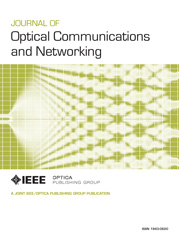Journal of Optical Communications and Networking (JOCN)
Special Issue on Future PON Architectures Enabled By Advanced Technology
Submissions Open: 6 January 2020
Submission Deadline: 18 February2020
Advanced optical and electronic technologies have become an integral part of backbone (i.e., long-haul) networks. Higher-order modulation formats, coherent reception and digital signal processing (DSP) have displaced conventional OOK/direct detection, enabling high data-rates and extended optical reach. The required capacity and reach in access networks are much more modest, while sensitivity to cost is much more pronounced. Thus, the adoption of advanced, typically costly, technology has been much slower in the access area. However, new technologies may offer alternative benefits in the context of an access network. Assessing these benefits, and their associated cost, is of growing interest.
This special issue is specifically focused on investigating the future of passive optical networks (PONs) in light of new enabling technologies. For example, coherent technology has been proposed for PON applications where it could offer capabilities such as greater extent and/or higher splitting ratios. Advanced DSP might be exploited to enable modulation and detection techniques that support high-speed transmission with low-speed optics. Tunable transceivers have recently been introduced through the development of NG-PON2. Additionally, there is IEEE and ITU standardization work supporting 2 x 25 Gb/s and 50 Gb/s line rates, respectively, with cutting-edge research exploring 100+ Gb/s rates.
How do these attributes change how PONs are architected and deployed? Could PONs become more attractive in a broader range of use cases? Will it better enable the trend towards open systems and disaggregation? Will it enable simpler system upgrades? What novel restoration schemes could be implemented? Can the benefits be achieved with general-purpose hardware as opposed to costly ASICs?
We would like the special issue to present a balanced view. Thus, economic analyses that delve into whether the advanced PON architectures are justified by the expected greater cost are welcomed. Similarly, studies that examine the overall power-consumption impact are suitable; we emphasize that holistic analyses are desired. Additionally, analyses that convincingly demonstrate that conventional technology will remain suitable to address PON requirements in the foreseeable future are in-scope as well. The special issue will also address what more needs to be done to enable PONs to better realize their full potential.
Specifically, the scope of the special issue includes but is not limited to the following topics:
- New PON architectures enabled by advanced technology
- Cost analyses and/or power-consumption analyses of future PON architectures based on advanced technology
- Tradeoff analyses of advanced vs. conventional technology in PONs
- Enabling technology, as long as it is presented in the context of what architectural benefits it endows
- New resource allocation and management schemes enabled by advanced technology
- Standardization efforts related to next-generation PONs enabled by advanced technology
Submissions to the special issue should be prepared according to the usual standards for the Journal of Optical Communications and Networking and will undergo the normal peer review process. Manuscripts must be uploaded through OSA's online submission system specifying from the Feature Issue drop-down menu that the manuscript is for the issue on Future PON Architectures Enabled By Advanced Technology.
Guest Editors
Roberto Gaudino, Politecnico di Torino, Italy (Lead Guest Editor)
Ren� Bonk, Nokia, Germany
Derek Nesset, Huawei Technologies, Germany
Josep Prat, Universitat Polit�cnica de Catalunya, Spain
Marco Ruffini, University of Dublin, Trinity College, Ireland

